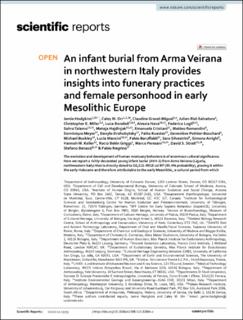An infant burial from Arma Veirana in northwestern Italy provides insights into funerary practices and female personhood in early Mesolithic Europe
Hodgkins, Jamie; Orr, Caley M.; Gravel-Miguel, Claudine; Riel-Salvatore, Julien; Miller, Christopher; Bondioli, Luca; Nava, Alessia; Lugli, Federico; Talamo, Sahra; Hajdinjak, Mateja; Cristiani, Emanuela; Romandini, Matteo; Meyer, Dominique; Drohobytsky, Danylo; Kuester, Falko; Pothier-Bouchard, Geneviève; Buckley, Mike; Mancini, Lucia; Baruffaldi, Fabio; Silvestrini, Sara; Arrighi, Simona; Keller, Hannah M.; Griggs, Rocío Belén; Peresani, Marco; Strait, David S.; Benazzi, Stefano; Negrino, Fabio
Journal article, Peer reviewed
Published version

Åpne
Permanent lenke
https://hdl.handle.net/11250/2983777Utgivelsesdato
2021Metadata
Vis full innførselSamlinger
Sammendrag
The evolution and development of human mortuary behaviors is of enormous cultural significance. Here we report a richly-decorated young infant burial (AVH-1) from Arma Veirana (Liguria, northwestern Italy) that is directly dated to 10,211–9910 cal BP (95.4% probability), placing it within the early Holocene and therefore attributable to the early Mesolithic, a cultural period from which well-documented burials are exceedingly rare. Virtual dental histology, proteomics, and aDNA indicate that the infant was a 40–50 days old female. Associated artifacts indicate significant material and emotional investment in the child’s interment. The detailed biological profile of AVH-1 establishes the child as the earliest European near-neonate documented to be female. The Arma Veirana burial thus provides insight into sex/gender-based social status, funerary treatment, and the attribution of personhood to the youngest individuals among prehistoric hunter-gatherer groups and adds substantially to the scant data on mortuary practices from an important period in prehistory shortly following the end of the last Ice Age.
